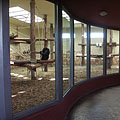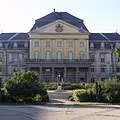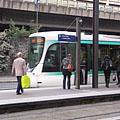(Optimiziran za naprave z majhnim zaslonom)
The Old Town in summer - Szentendre, Madžarska
Ko kliknete:
Kliknite na slike!
-
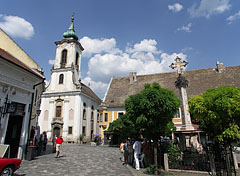
Blagovestenska Serbian Orthodox Church ("Greek Church") and the baroque and rococo style Plague Cross in the center of the square
Datum fotografiranja: 5.7.20062006
Ustvaril: Robert Németh
Model fotoaparata: Konica Minolta Dimage A200
Szentendre, Madžarska
-
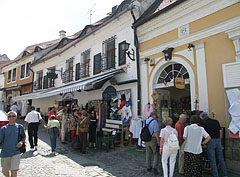
The narrow streets are always crowdy, especially in summertime
Datum fotografiranja: 5.7.20062006
Ustvaril: Robert Németh
Model fotoaparata: Konica Minolta Dimage A200
Szentendre, Madžarska
-

Blagovestenska Serbian Orthodox Church (so called "Greek Church")
Datum fotografiranja: 5.7.20062006
Ustvaril: Robert Németh
Model fotoaparata: Konica Minolta Dimage A200
Szentendre, Madžarska
-
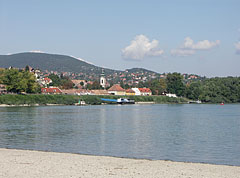
View of Szentendre from River Danube
Datum fotografiranja: 28.9.20082008
Ustvaril: Robert Németh
Model fotoaparata: Konica Minolta Dimage A200
Szentendre, Madžarska
-

Restaurant in front of the Chirch Hill with the Roman Catholic Parish Church (Castle Church) on the top of the hill
Datum fotografiranja: 28.9.20082008
Ustvaril: Robert Németh
Model fotoaparata: Konica Minolta Dimage A200
Szentendre, Madžarska
-

Main square of Szentendre, with the Blagovestenska Serbian Orthodox Church ("Greek Church")
Datum fotografiranja: 5.7.20062006
Ustvaril: Robert Németh
Model fotoaparata: Konica Minolta Dimage A200
Szentendre, Madžarska
-
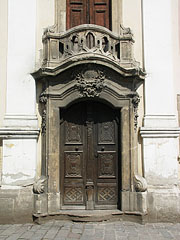
Entrance of the Blagovestenska Serbian Orthodox Church (or "Greek Church")
Datum fotografiranja: 5.7.20062006
Ustvaril: Robert Németh
Model fotoaparata: Konica Minolta Dimage A200
Szentendre, Madžarska
-
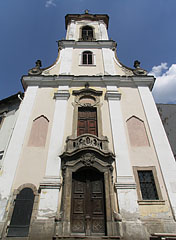
Blagovestenska Serbian Orthodox Church (so called "Greek Church")
Datum fotografiranja: 5.7.20062006
Ustvaril: Robert Németh
Model fotoaparata: Konica Minolta Dimage A200
Szentendre, Madžarska
-

Steeple (tower) of Blagovestenska Serbian Orthodox Church ("Greek Church")
Datum fotografiranja: 5.7.20062006
Ustvaril: Robert Németh
Model fotoaparata: Konica Minolta Dimage A200
Szentendre, Madžarska
-
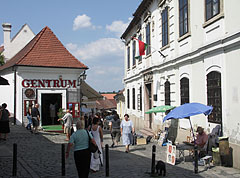
Passers-by and working artists within walking distance of each other
Datum fotografiranja: 5.7.20062006
Ustvaril: Robert Németh
Model fotoaparata: Konica Minolta Dimage A200
Szentendre, Madžarska
-
Air-conditioned shop
Datum fotografiranja: 5.7.20062006
Ustvaril: Robert Németh
Model fotoaparata: Konica Minolta Dimage A200
Szentendre, Madžarska
Air-conditioned shop - Szentendre, Madžarska -
Streetscape with merchandises
Datum fotografiranja: 5.7.20062006
Ustvaril: Robert Németh
Model fotoaparata: Konica Minolta Dimage A200
Szentendre, Madžarska
Streetscape with merchandises - Szentendre, Madžarska -
The cobble stoned alley way goes to the verdant Church Hill (Templomdomb)
Datum fotografiranja: 5.7.20062006
Ustvaril: Robert Németh
Model fotoaparata: Konica Minolta Dimage A200
Szentendre, Madžarska
The cobble stoned alley way goes to the verdant Church Hill (Templomdomb) - Szentendre, Madžarska -
The Church Hill with the Roman Catholic Parish Church on the top
Datum fotografiranja: 5.7.20062006
Ustvaril: Robert Németh
Model fotoaparata: Konica Minolta Dimage A200
Szentendre, Madžarska
The Church Hill with the Roman Catholic Parish Church on the top - Szentendre, Madžarska -
The stairway to the Church Hill is lined with restaurants and cafés
Datum fotografiranja: 5.7.20062006
Ustvaril: Robert Németh
Model fotoaparata: Konica Minolta Dimage A200
Szentendre, Madžarska
The stairway to the Church Hill is lined with restaurants and cafés - Szentendre, Madžarska -
St. John the Baptist Roman Catholic Parish Church (Keresztelő Szent János templom, sometimes called Castle Church)
Datum fotografiranja: 5.7.20062006
Ustvaril: Robert Németh
Model fotoaparata: Konica Minolta Dimage A200
Szentendre, Madžarska
St. John the Baptist Roman Catholic Parish Church (Keresztelő Szent János templom, sometimes called Castle Church) - Szentendre, Madžarska -
Saint John the Baptist Roman Catholic Parish Church (or Castle Church, in Hungarian Keresztelő Szent János templom)
Datum fotografiranja: 28.9.20082008
Ustvaril: Robert Németh
Model fotoaparata: Konica Minolta Dimage A200
Szentendre, Madžarska
Saint John the Baptist Roman Catholic Parish Church (or Castle Church, in Hungarian Keresztelő Szent János templom) - Szentendre, Madžarska -
Narrow alley way and the entrance of the Serbian Orthodox Episcopal Cathedral (Beograda Church or Belgrade Church)
Datum fotografiranja: 5.7.20062006
Ustvaril: Robert Németh
Model fotoaparata: Konica Minolta Dimage A200
Szentendre, Madžarska
Narrow alley way and the entrance of the Serbian Orthodox Episcopal Cathedral (Beograda Church or Belgrade Church) - Szentendre, Madžarska -
Wrought iron gate of the Orthodox Episcopal Cathedral (Beograda Church or Belgrade Church)
Datum fotografiranja: 5.7.20062006
Ustvaril: Robert Németh
Model fotoaparata: Konica Minolta Dimage A200
Szentendre, Madžarska
Wrought iron gate of the Orthodox Episcopal Cathedral (Beograda Church or Belgrade Church) - Szentendre, Madžarska -
Serbian Orthodox Episcopal Cathedral (Beograda Church or Belgrade Church)
Datum fotografiranja: 28.9.20082008
Ustvaril: Robert Németh
Model fotoaparata: Konica Minolta Dimage A200
Szentendre, Madžarska
Serbian Orthodox Episcopal Cathedral (Beograda Church or Belgrade Church) - Szentendre, Madžarska -
Steeple of the Serbian Orthodox Episcopal Cathedral (Beograda Church or Belgrade Church)
Datum fotografiranja: 28.9.20082008
Ustvaril: Robert Németh
Model fotoaparata: Konica Minolta Dimage A200
Szentendre, Madžarska
Steeple of the Serbian Orthodox Episcopal Cathedral (Beograda Church or Belgrade Church) - Szentendre, Madžarska -
Steeple of the Reformed Opovacka (or Opovacska) Church in Rákóczy Street
Datum fotografiranja: 5.7.20062006
Ustvaril: Robert Németh
Model fotoaparata: Konica Minolta Dimage A200
Szentendre, Madžarska
Steeple of the Reformed Opovacka (or Opovacska) Church in Rákóczy Street - Szentendre, Madžarska -
Image of Saint Nicholas bishop of Myra on an older house
The legend of the Santa Claus is based on St. Nicholas, a real person.
Datum fotografiranja: 5.7.20062006
Ustvaril: Robert Németh
Model fotoaparata: Konica Minolta Dimage A200
Szentendre, Madžarska
Image of Saint Nicholas bishop of Myra on an older house - Szentendre, Madžarska -
Picture of Bishop Saint Nicholas of Myra on the wall of a old house, there are a crosier and the book of Gospel in his hands
Datum fotografiranja: 5.7.20062006
Ustvaril: Robert Németh
Model fotoaparata: Konica Minolta Dimage A200
Szentendre, Madžarska
Picture of Bishop Saint Nicholas of Myra on the wall of a old house, there are a crosier and the book of Gospel in his hands - Szentendre, Madžarska -
Houses of Szentendre are literally diverse and multicolored
Datum fotografiranja: 5.7.20062006
Ustvaril: Robert Németh
Model fotoaparata: Konica Minolta Dimage A200
Szentendre, Madžarska
Houses of Szentendre are literally diverse and multicolored - Szentendre, Madžarska -
Even today many people wals on the paving stones of Szentendre
Datum fotografiranja: 5.7.20062006
Ustvaril: Robert Németh
Model fotoaparata: Konica Minolta Dimage A200
Szentendre, Madžarska
Even today many people wals on the paving stones of Szentendre - Szentendre, Madžarska -
The Plague Cross is hiding between sprawling acacia trees
Datum fotografiranja: 5.7.20062006
Ustvaril: Robert Németh
Model fotoaparata: Konica Minolta Dimage A200
Szentendre, Madžarska
The Plague Cross is hiding between sprawling acacia trees - Szentendre, Madžarska -
Building of the Serbian Trading House (Szerb Kereskedőház) from the 18th century, today it is an art work gallery
Datum fotografiranja: 5.7.20062006
Ustvaril: Robert Németh
Model fotoaparata: Konica Minolta Dimage A200
Szentendre, Madžarska
Building of the Serbian Trading House (Szerb Kereskedőház) from the 18th century, today it is an art work gallery - Szentendre, Madžarska -
Régimódi Vendéglő ("Old Fashioned Restaurant")
Datum fotografiranja: 5.7.20062006
Ustvaril: Robert Németh
Model fotoaparata: Konica Minolta Dimage A200
Szentendre, Madžarska
Régimódi Vendéglő ("Old Fashioned Restaurant") - Szentendre, Madžarska -
Somebody built a genuine Mediterranean atmosphere with secret tricks into the walls and stones of the Görög Street
Datum fotografiranja: 5.7.20062006
Ustvaril: Robert Németh
Model fotoaparata: Konica Minolta Dimage A200
Szentendre, Madžarska
Somebody built a genuine Mediterranean atmosphere with secret tricks into the walls and stones of the Görög Street - Szentendre, Madžarska -
Intimate atmosphere on the Danube Promenade (Dunakorzó)
Datum fotografiranja: 5.7.20062006
Ustvaril: Robert Németh
Model fotoaparata: Konica Minolta Dimage A200
Szentendre, Madžarska
Intimate atmosphere on the Danube Promenade (Dunakorzó) - Szentendre, Madžarska -
Datum fotografiranja: 5.7.20062006
Ustvaril: Robert Németh
Model fotoaparata: Konica Minolta Dimage A200
Szentendre, Madžarska
- Szentendre, Madžarska -
The promenade beside River Danube is long stretched on the outskirts, that's the best place to relax
Datum fotografiranja: 28.9.20082008
Ustvaril: Robert Németh
Model fotoaparata: Konica Minolta Dimage A200
Szentendre, Madžarska
The promenade beside River Danube is long stretched on the outskirts, that's the best place to relax - Szentendre, Madžarska -
View of Szentendre from River Danube
Datum fotografiranja: 28.9.20082008
Ustvaril: Robert Németh
Model fotoaparata: Konica Minolta Dimage A200
Szentendre, Madžarska
View of Szentendre from River Danube - Szentendre, Madžarska -
Datum fotografiranja: 5.7.20062006
Ustvaril: Robert Németh
Model fotoaparata: Konica Minolta Dimage A200
Szentendre, Madžarska
- Szentendre, Madžarska -
Datum fotografiranja: 5.7.20062006
Ustvaril: Robert Németh
Model fotoaparata: Konica Minolta Dimage A200
Szentendre, Madžarska
- Szentendre, Madžarska -
Datum fotografiranja: 5.7.20062006
Ustvaril: Robert Németh
Model fotoaparata: Konica Minolta Dimage A200
Szentendre, Madžarska
- Szentendre, Madžarska -
Datum fotografiranja: 5.7.20062006
Ustvaril: Robert Németh
Model fotoaparata: Konica Minolta Dimage A200
Szentendre, Madžarska
- Szentendre, Madžarska -
Datum fotografiranja: 5.7.20062006
Ustvaril: Robert Németh
Model fotoaparata: Konica Minolta Dimage A200
Szentendre, Madžarska
- Szentendre, Madžarska -
Datum fotografiranja: 5.7.20062006
Ustvaril: Robert Németh
Model fotoaparata: Konica Minolta Dimage A200
Szentendre, Madžarska
- Szentendre, Madžarska -
Datum fotografiranja: 5.7.20062006
Ustvaril: Robert Németh
Model fotoaparata: Konica Minolta Dimage A200
Szentendre, Madžarska
- Szentendre, Madžarska -
Datum fotografiranja: 5.7.20062006
Ustvaril: Robert Németh
Model fotoaparata: Konica Minolta Dimage A200
Szentendre, Madžarska
- Szentendre, Madžarska -
Datum fotografiranja: 5.7.20062006
Ustvaril: Robert Németh
Model fotoaparata: Konica Minolta Dimage A200
Szentendre, Madžarska
- Szentendre, Madžarska -
Datum fotografiranja: 5.7.20062006
Ustvaril: Robert Németh
Model fotoaparata: Konica Minolta Dimage A200
Szentendre, Madžarska
- Szentendre, Madžarska -
Datum fotografiranja: 5.7.20062006
Ustvaril: Robert Németh
Model fotoaparata: Konica Minolta Dimage A200
Szentendre, Madžarska
- Szentendre, Madžarska -
Datum fotografiranja: 5.7.20062006
Ustvaril: Robert Németh
Model fotoaparata: Konica Minolta Dimage A200
Szentendre, Madžarska
- Szentendre, Madžarska -
Datum fotografiranja: 5.7.20062006
Ustvaril: Robert Németh
Model fotoaparata: Konica Minolta Dimage A200
Szentendre, Madžarska
- Szentendre, Madžarska -
Datum fotografiranja: 5.7.20062006
Ustvaril: Robert Németh
Model fotoaparata: Konica Minolta Dimage A200
Szentendre, Madžarska
- Szentendre, Madžarska -
Datum fotografiranja: 28.9.20082008
Ustvaril: Robert Németh
Model fotoaparata: Konica Minolta Dimage A200
Szentendre, Madžarska
- Szentendre, Madžarska -
Datum fotografiranja: 28.9.20082008
Ustvaril: Robert Németh
Model fotoaparata: Konica Minolta Dimage A200
Szentendre, Madžarska
- Szentendre, Madžarska -
Datum fotografiranja: 28.9.20082008
Ustvaril: Robert Németh
Model fotoaparata: Konica Minolta Dimage A200
Szentendre, Madžarska
- Szentendre, Madžarska -
Datum fotografiranja: 28.9.20082008
Ustvaril: Robert Németh
Model fotoaparata: Konica Minolta Dimage A200
Szentendre, Madžarska
- Szentendre, Madžarska -
Datum fotografiranja: 28.9.20082008
Ustvaril: Robert Németh
Model fotoaparata: Konica Minolta Dimage A200
Szentendre, Madžarska
- Szentendre, Madžarska -
Datum fotografiranja: 28.9.20082008
Ustvaril: Robert Németh
Model fotoaparata: Konica Minolta Dimage A200
Szentendre, Madžarska
- Szentendre, Madžarska -
Datum fotografiranja: 28.9.20082008
Ustvaril: Robert Németh
Model fotoaparata: Konica Minolta Dimage A200
Szentendre, Madžarska
- Szentendre, Madžarska -
Datum fotografiranja: 28.9.20082008
Ustvaril: Robert Németh
Model fotoaparata: Konica Minolta Dimage A200
Szentendre, Madžarska
- Szentendre, Madžarska -
Datum fotografiranja: 28.9.20082008
Ustvaril: Robert Németh
Model fotoaparata: Konica Minolta Dimage A200
Szentendre, Madžarska
- Szentendre, Madžarska -
Datum fotografiranja: 28.9.20082008
Ustvaril: Robert Németh
Model fotoaparata: Konica Minolta Dimage A200
Szentendre, Madžarska
- Szentendre, Madžarska
Kliknite na slike!
Značilnosti, lastnosti
Položaj:
GPS koordinate: Širina 47°40'3", Dolžina 19°4'33" (N47 40.05 - E19 4.55)
Informacije, kratke zgodbe, zanimivih dejstev
 Main square of Szentendre, with the Blagovestenska Serbian Orthodox Church ("Greek Church")
Main square of Szentendre, with the Blagovestenska Serbian Orthodox Church ("Greek Church")
Szentendre is often called a jewelry box due to its diversity and variegation. If it is true, then the town square is the crown jewel in it.
 Blagovestenska Serbian Orthodox Church (so called "Greek Church")
Blagovestenska Serbian Orthodox Church (so called "Greek Church")
Initially on the site of the Blagovestenska Church (the Serbian word means "Annunciation to the Blessed Virgin Mary") there was a wooden church. That was built in 1690 by Greek, Serbian and other people from the Balkans, who were fleeing from the Turks and settled down in the area between the town square and the Danube bank of Szentendre. Later the iconostasis (which was painted in 1721 and represents the "Annunciation of Our Lady") of that wooden church was moved to the church in Izbég. Formerly Izbég was an independent settlement, but today it is a part of Szentendre town.
The current baroque and rococo style stone building was supposedly designed by Andreas Mayerhoffer, just like the Serbian church in Pest or the Cathedral of Kalocsa, which are quite similar to this church in Szentendre. The Blagovestenska Church was consecrated in 1754 and dedicated to the "Annunciation of Our Lady" (in Hungarian "Gyümölcsoltó Boldogasszony"). The most important treasures of the church are the furnitures from the 18th century, the rococo iconostasis and the episcopal throne with canopy.
From the 1920s onwards there were less and less liturgies and religious ceremonies, and nowadays the Blagovestenska Church functions primarily as a museum.
 The cobble stoned alley way goes to the verdant Church Hill (Templomdomb)
The cobble stoned alley way goes to the verdant Church Hill (Templomdomb)
It may seem that the small cobbled and narrow streets of Szentendre have Mediterranean atmosphere. Those who feel like this are right, because beside the Hungarians there were people of several nations from the Balkans and its surroundings who settled down in this town, already centuries ago. They brought their culture and of course their architectural styles here which contributed to the diversity of Szentendre. Among other things this is why the town is often called a "jewelry box".
 St. John the Baptist Roman Catholic Parish Church (Keresztelő Szent János templom, sometimes called Castle Church)
St. John the Baptist Roman Catholic Parish Church (Keresztelő Szent János templom, sometimes called Castle Church)
The Roman Catholic so-called "Castle Church" (in Hungarian "Vártemplom", officially St. John the Baptist Parish Church or "Keresztelő Szent János-plébániatemplom") was the first stone church of Szentendre, and also the oldest building of the town. The church had already four reconstructions, but the styles of the different ages (the romanesque, the gothic and the baroque) have a harmonious mix in this building.
Szentendre was under the jurisdiction of the bishopric of Veszprém already in 1002. In the 13th century the settlement became the archdeacon's seat, and at that time the building of a church was begun on the top of the "Várdomb" ("Castle Hill"), where the traces of it still can be found. In the 14th century it was converted to a gothic church that already has the same layout and floorplan as the current church. Later Roman Catholic Dalmats used it who fled here from the Turks, but in those times the church became ruined and it was renovated only in the 17th century.
The baroque rebuilding was supported by the Zichy family and it was begun in 1710. In the mid-18th century the church almost received its final, present-day form, but in 1818 its ornate tower was collapsed and it got the current simplier spire only after then. Below the tower on a support pillar there is a unique sun-dial, which was carved from a single stone in the 1300s.
 Narrow alley way and the entrance of the Serbian Orthodox Episcopal Cathedral (Beograda Church or Belgrade Church)
Narrow alley way and the entrance of the Serbian Orthodox Episcopal Cathedral (Beograda Church or Belgrade Church)
Many people probably do not even realize that Belgrade (in Serbian "Beograd"), the current capital city of Serbia is actually the medieval Nándorfehérvár town. Until the Hungarian language reform period (ca. 1770-1872) the town was called "Lándorfejérvár" in Hungarian, in which the word "lándor" means "Danube Bulgarian people", as well as "fejérvár" or "fehérvár" means "white castle".
The Battle of Belgrade or Siege of Nándorfehérvár in 1456 was a very important event of the Hungarian-Turkish wars. The tenfold outnumbered Christian Hungarian defenders gained a huge victory over the Ottoman troops of Sultan Mehmed II. The Hungarian army was led by John Hunyadi (in Hungarian "Hunyadi János", father of King Matthias Corvinus of Hungary), as well as the leaders of the castle defenders were his brother-in-law Michael Szilágyi and John of Capistrano (in Hungarian "Szilágyi Mihály" and "Kapisztrán János"). The triumph stopped the Turkish expansion into Europe for about seventy years, and in memory of the victory the church bells are rang at noon every day in whole Hungary.
However, it should be mentioned that the daily noon bell was ordered by Pope Callixtus III already about a month before the victory (29 June vs. 22 July of 1456) to call the Christian believers to a daily prayer, similarly as the Muslims do. In Hungary and some other European countries the two events were merged and the noon bell is attributed only to the Nándorfehérvár (Belgrade) victory. Moreover, it is a tradition in Hungary since decades ago that the bells are ringing every day at noon on the public service television and radio channels as well.
It should be also noted that the French-born castle defender St. John of Capistrano (Giovanni da Capestrano) was also an Italian speaker and theologian, as well as a leader of Crusader armies and today one of the patron saints of Hungary.
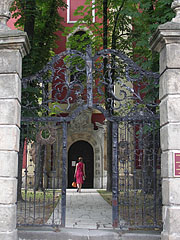 Wrought iron gate of the Orthodox Episcopal Cathedral (Beograda Church or Belgrade Church)
Wrought iron gate of the Orthodox Episcopal Cathedral (Beograda Church or Belgrade Church)
The single-towered and typical Hungarian baroque style Belgrade Church was built in the mid-18th century. The ornate rococo style wrought-iron gate is a work of the local master locksmith Márton Ginesser from 1772. Inside the church the most important values are primarily the large, gilded and colored linden-wood iconostasis (the icon on it was created by Vazul Ösztovics in 1781), as well as the canopied altar table, the gold-plated linden-wood pulpit and the other rococo furnitures.
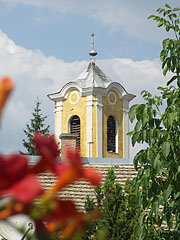 Steeple of the Reformed Opovacka (or Opovacska) Church in Rákóczy Street
Steeple of the Reformed Opovacka (or Opovacska) Church in Rákóczy Street
The baroque Protestant (Reformed) church was built in 1746, then in 1770 it was extended, but the tower was completed only in 1777. Formerly it was called Opovacka Church, because it was erected by refugees from Opovac, Serbia, on the site of an earlier wooden church. The Reformed Church received the building in 1913, and its former iconostasis was moved to a church in Hercegszántó village.
 Blagovestenska Serbian Orthodox Church ("Greek Church") and the baroque and rococo style Plague Cross in the center of the square
Blagovestenska Serbian Orthodox Church ("Greek Church") and the baroque and rococo style Plague Cross in the center of the square
The main square of Szentendre wasn't designated in an office, but it is a naturally formed town center, probably already since the Middle Ages. Not so long ago it was a junction of three main roads, there was car traffic even directly around the Plague Cross. Fortunately today only the pedestrian passers-by allowed to use the square (and sometimes a horse-drawn carriage as well, for the delight of tourists).
 The Plague Cross is hiding between sprawling acacia trees
The Plague Cross is hiding between sprawling acacia trees
The late-rococo style Orthodox metal cross is decorated with icons and standing on a stone pedestal, it was set by the Serbian Trade Association in 1763 (so that's why it is also called "Merchants' Cross"). It was erected to express the people's gratitude that the town escaped from the plague. According to the folk tradition there is a person buried upside down under the cross.
Szentendre - Več galerij fotografija:
Mogoče bi vas tudi zanima (Sorodne strani):
Destinacije v turističnega vodnika:
Szentendre (597 fotografije + 1 panoramske slike)
Danube Bend (Dunakanyar) (1 769 fotografije + 6 panoramske slike)
Pest megye (county) (15 122 fotografije + 50 panoramske slike)
Budimpešta z okolico (Osrednja Madžarska) (15 989 fotografije + 52 panoramske slike)
Madžarska (27 287 fotografije + 163 panoramske slike)
in poleg tega:
(v tukaj: Pest megye in Danube Bend)
Pilis Mountains (Pilis hegység) (335 fotografije)
Buda Hills (Budai-hegység) (8 632 fotografije + 21 panoramske slike)
Gödöllő Hills (Gödöllői-dombság) (4 203 fotografije + 21 panoramske slike)
Visegrád Mountains (Visegrádi-hegység) (116 fotografije + 1 panoramske slike)
Cegléd (125 fotografije + 2 panoramske slike)
Ráckeve (92 fotografije)
Dunakeszi (259 fotografije)
Göd (23 fotografije)
Nagykőrös (250 fotografije + 2 panoramske slike)
Nagymaros (31 fotografije)
Pilisvörösvár (88 fotografije)
Vác (232 fotografije + 2 panoramske slike)
Visegrád (220 fotografije + 1 panoramske slike)
Esztergom (110 fotografije + 1 panoramske slike)
Dunakeszi (259 fotografije)
Göd (23 fotografije)
Nagymaros (31 fotografije)
Vác (232 fotografije + 2 panoramske slike)
Visegrád (220 fotografije + 1 panoramske slike)
Csővár (105 fotografije)
Kóspallag (53 fotografije)
Márianosztra (37 fotografije)
Nagybörzsöny (4 fotografije)
Pilisszentkereszt (122 fotografije)
Nógrád (181 fotografije)
Zsámbék
Vsaka panoramska fotografija tukaj:
Szentendre (1 fotografije)
Danube Bend (Dunakanyar) (6 fotografije)
Pest megye (county) (50 fotografije)
Budimpešta z okolico (Osrednja Madžarska) (52 fotografije)
Madžarska (163 fotografije)
Evropa (165 fotografije)
Vsaka normalna fotografija tukaj:
Szentendre (597 fotografije / 11 galerije)
Danube Bend (Dunakanyar) (1 769 fotografije / 31 galerije)
Pest megye (county) (15 122 fotografije / 221 galerije)
Budimpešta z okolico (Osrednja Madžarska) (15 989 fotografije / 234 galerije)
Madžarska (27 287 fotografije / 462 galerije)
Evropa (30 494 fotografije / 523 galerije)
https://www.panadea.com/sl/guidebook/szentendre/photos/gal-001

Dodaj med Priljubljene Dodaj med Priljubljene
Delite s svojimi prijatelji!
itd
O podjetju - Zanikanje odgovornosti -
Vse pravice pridržane
- ©2010-2022
Neuronit Creative Studio - Mogyoród / Budimpešta / Madžarska


